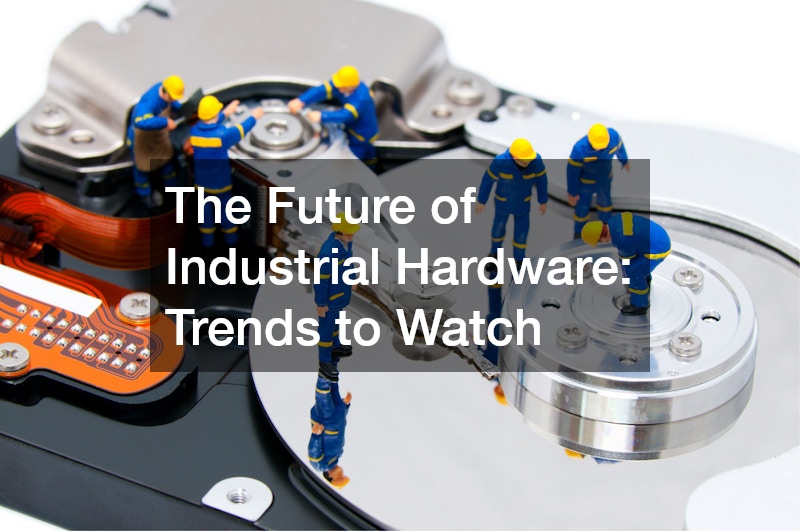The landscape of industrial hardware is evolving rapidly, driven by technological innovation, sustainability imperatives, and shifting global market demands. As industries like manufacturing, mining, construction, and logistics face increased pressure to streamline operations and adopt smarter, more efficient tools, the hardware sector is undergoing a significant transformation. With automation, connectivity, and environmental responsibility at the forefront, understanding the future of industrial hardware is essential for businesses aiming to remain competitive in an increasingly digitised and eco-conscious world.
Smart Technology & Industrial Hardware Integration
One of the most compelling trends reshaping the future of industrial hardware is the integration of smart technologies. As the Internet of Things (IoT) continues to mature, sensors and wireless connectivity are becoming standard features in many hardware products. This shift enables equipment to collect and transmit data in real-time, offering insights into usage, wear patterns, maintenance needs, and operational efficiency. For example, smart fasteners and torque tools can now monitor tension levels and provide alerts when they need recalibration, helping prevent equipment failure and improving workplace safety.
Moreover, cloud connectivity allows for remote diagnostics and predictive maintenance, which significantly reduces downtime. Companies investing in this kind of intelligent hardware are not only enhancing their operational resilience but also building a foundation for long-term cost savings. As artificial intelligence is increasingly used to analyse the collected data, the future of industrial hardware will lean heavily on automation-driven decision-making and proactive asset management.
Sustainability & Eco-Conscious Design
Environmental sustainability is no longer a peripheral concern; it has become a core driver of innovation in industrial hardware. Manufacturers and end-users alike are under growing pressure to reduce their carbon footprints and minimise waste. This demand is leading to the creation of more energy-efficient tools and components made from recyclable or biodegradable materials. Lightweight but durable materials like carbon fibre composites and high-strength polymers are gaining traction, reducing energy consumption during transportation and improving product longevity.
Reusability and reparability are also gaining prominence in hardware design. Products that can be disassembled and reassembled with minimal waste or that feature modular components are aligning with the principles of a circular economy. As government regulations and consumer expectations continue to shift in favour of green practices, hardware manufacturers are adopting design philosophies that emphasise lifecycle impact. Businesses that prioritise these eco-friendly advancements are not only meeting compliance requirements but are also positioning themselves as leaders in sustainable industrial practices.
Digital Supply Chains & On-Demand Manufacturing
Another significant development in the realm of industrial hardware is the digitalisation of supply chains. Cloud-based platforms and advanced planning tools are enabling better visibility, responsiveness, and coordination across the procurement and distribution process. These technologies make it easier to manage inventory levels, reduce lead times, and adjust to fluctuating market demands with greater agility.
One standout innovation is the rise of on-demand and additive manufacturing, particularly 3D printing. With 3D printing, companies can produce custom hardware components locally, cutting down on shipping times and costs. As the technology becomes more affordable and accessible, it is poised to revolutionise how industrial hardware is produced and delivered.
Human-Centric Automation & Safety Enhancements
While automation is widely recognised for boosting productivity, it’s equally crucial to note how it is improving human-machine collaboration. In the past, industrial hardware was often designed with a primary focus on mechanical performance. Today, however, there’s a growing emphasis on user experience and ergonomic design. Wearable technology, voice-controlled tools, and collaborative robots (cobots) are examples of innovations that support workers rather than replace them.
Cobots, in particular, represent a pivotal shift in how industrial hardware operates. Unlike traditional robots that require extensive safety fencing and isolation, cobots work safely alongside humans, enhancing efficiency while reducing the risk of injury. These intelligent machines can take on repetitive or physically demanding tasks, freeing workers to focus on higher-value responsibilities. As occupational safety regulations evolve, the demand for hardware that enhances human well-being will continue to grow.
Resilience & Cybersecurity in Connected Systems
As industrial hardware becomes more interconnected, the risk of cyber threats also increases. A compromised piece of equipment can have cascading effects across a networked manufacturing floor or logistics operation. Recognising this, developers are investing heavily in cybersecurity protocols embedded directly within the hardware itself. Secure firmware updates, encrypted data transmission, and user authentication protocols are becoming standard in high-tech tools and machinery.
The emphasis on cybersecurity is not just about protecting digital infrastructure; it’s about ensuring operational continuity. In environments where downtime can result in significant financial losses or safety hazards, secure and resilient hardware systems are paramount. Businesses that adopt secure-by-design principles in their hardware selections will be better prepared to navigate an era where physical tools and digital systems are inseparably linked.
Looking Ahead: A Transformative Era for Industrial Hardware
The future of industrial hardware is characterised by convergence. Technologies that were once distinct—such as data analytics, robotics, and materials science—are now working in tandem to create smarter, safer, and more sustainable solutions. From factory floors to construction sites, the role of industrial hardware is expanding from passive support equipment to active contributors in business intelligence and operational strategy.
For companies seeking to invest wisely, now is the time to explore partnerships with forward-looking suppliers and manufacturers who prioritise innovation, sustainability, and safety. As the sector continues to evolve, those who keep pace with emerging trends will gain a critical edge in a competitive global market.









